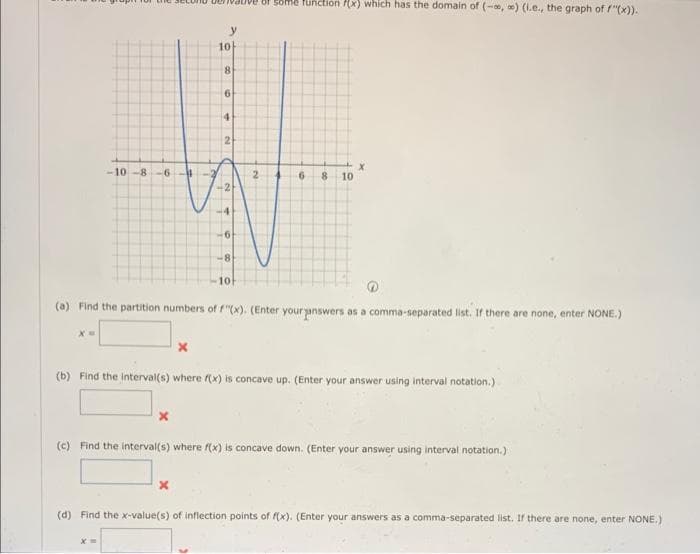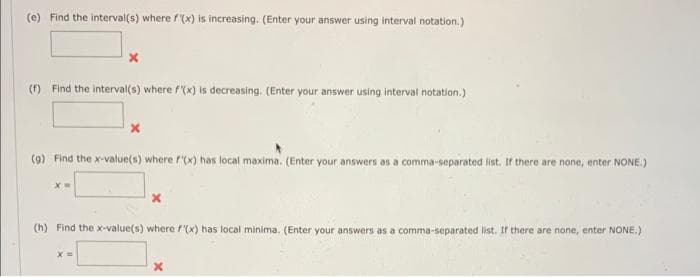-10-8-6 후 N VA x 6 10 P 6 8 10 X (a) Find the partition numbers of F"(x). (Enter your answers as a comma-separated list. If there are none, enter NONE.) x= (b) Find the interval(s) where f(x) is concave up. (Enter your answer using interval notation.) (c) Find the interval(s) where f(x) is concave down. (Enter your answer using interval notation.) (d) Find the x-value(s) of inflection points of f(x). (Enter your answers as a comma-separated list. If there are none, enter NONE.)
-10-8-6 후 N VA x 6 10 P 6 8 10 X (a) Find the partition numbers of F"(x). (Enter your answers as a comma-separated list. If there are none, enter NONE.) x= (b) Find the interval(s) where f(x) is concave up. (Enter your answer using interval notation.) (c) Find the interval(s) where f(x) is concave down. (Enter your answer using interval notation.) (d) Find the x-value(s) of inflection points of f(x). (Enter your answers as a comma-separated list. If there are none, enter NONE.)
Algebra & Trigonometry with Analytic Geometry
13th Edition
ISBN:9781133382119
Author:Swokowski
Publisher:Swokowski
Chapter4: Polynomial And Rational Functions
Section4.5: Rational Functions
Problem 54E
Related questions
Question
Question above graph: Given is the graph for the second derivative of some function f(x) which has the domain of (−∞, ∞) (i.e., the graph of f ''(x)).

Transcribed Image Text:-10-8-6
X=
10
8
6
4
2
VA
4
N
6
-8
10
2
of some function (x) which has the domain of (-∞, ∞) (i.e., the graph of F"(x)).
6
8 10
X
(a) Find the partition numbers of f(x). (Enter your answers as a comma-separated list. If there are none, enter NONE.)
(b) Find the interval(s) where f(x) is concave up. (Enter your answer using interval notation.)
(c) Find the interval(s) where f(x) is concave down. (Enter your answer using interval notation.)
(d) Find the x-value(s) of inflection points of f(x). (Enter your answers as a comma-separated list. If there are none, enter NONE.)

Transcribed Image Text:(e) Find the interval(s) where f(x) is increasing. (Enter your answer using interval notation.)
x
(f) Find the interval(s) where f(x) is decreasing. (Enter your answer using interval notation.)
X
(9) Find the x-value(s) where f'(x) has local maxima. (Enter your answers as a comma-separated list. If there are none, enter NONE.)
(h) Find the x-value(s) where f'(x) has local minima. (Enter your answers as a comma-separated list. If there are none, enter NONE.)
Expert Solution
This question has been solved!
Explore an expertly crafted, step-by-step solution for a thorough understanding of key concepts.
This is a popular solution!
Trending now
This is a popular solution!
Step by step
Solved in 4 steps with 3 images

Recommended textbooks for you

Algebra & Trigonometry with Analytic Geometry
Algebra
ISBN:
9781133382119
Author:
Swokowski
Publisher:
Cengage

Algebra & Trigonometry with Analytic Geometry
Algebra
ISBN:
9781133382119
Author:
Swokowski
Publisher:
Cengage